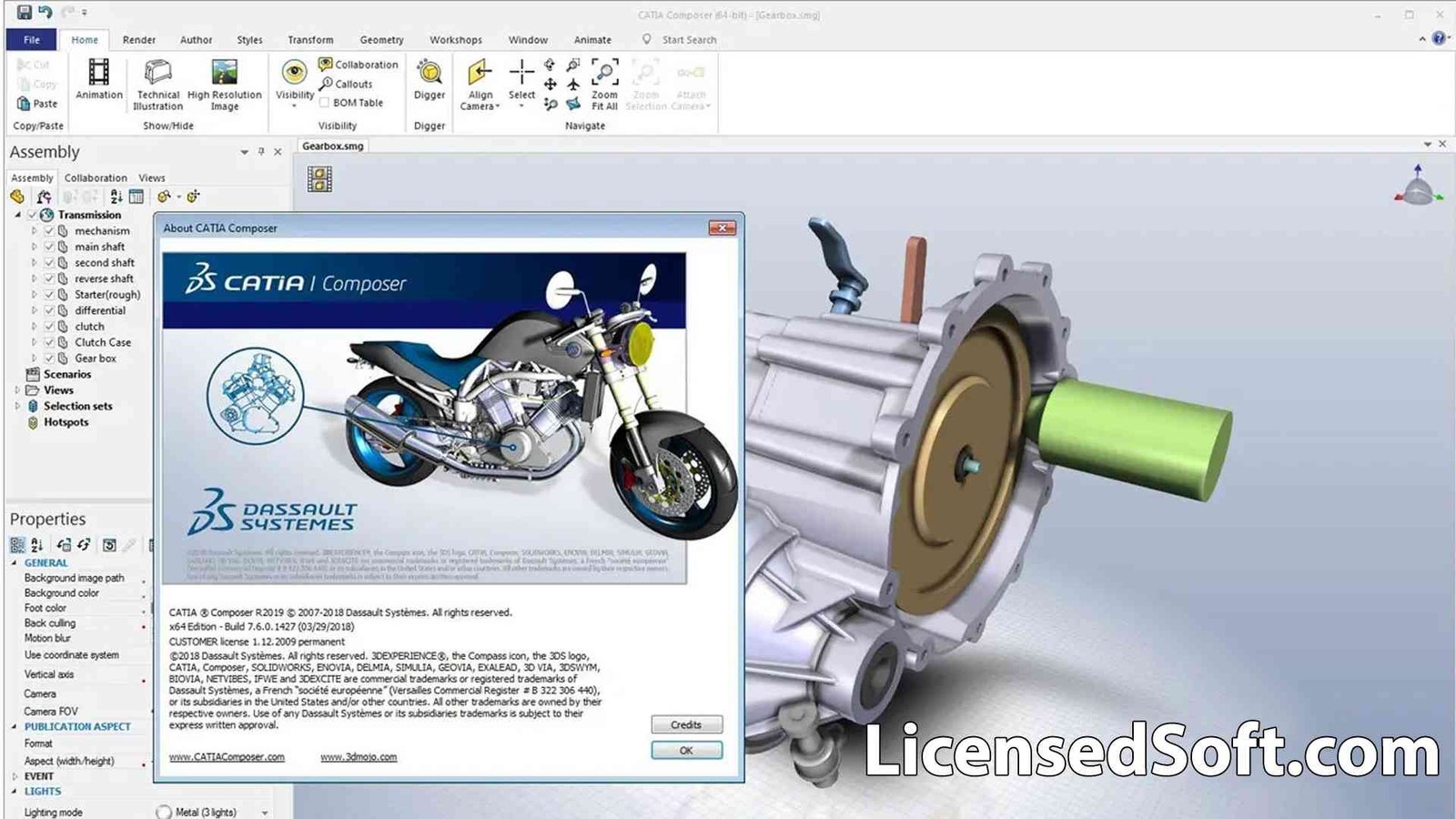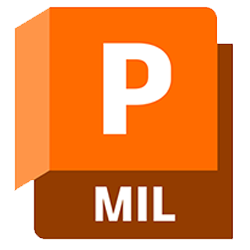CATIA Composer R2023 version is a newly launched professional 3D auxiliary design software, designed to help users easily use existing 3D design data and create high-quality products, including various high-quality documents, technical illustrations, animations and Interactive 3D experiences and more Thanks to support for multiple file formats, CATIA Composer allows you to use the entire product even if it was created in a different CAD system. Work results can saved in native CATIA Composer format, with the free viewer added automatically, or exported to common standard data formats such as PDF, HTML, AVI, and SVG.
CATIA Composer is a convenient and powerful multimedia content development system that automates the creation of assembly/disassembly instructions, technical illustrations, interactive 3D animations, marketing materials, product catalogs, training materials, web pages and more.
Catia Composer R2023 New Features:
1. Design for Composer
- Now you can use Design with Composer to connect Composer to 3DEXPERIENCE Platform.
- Design for Composer provides a multi-site management solution for Composer content. As a designer, creator or illustrator, you can access, share and manage 3DEXPERIENCE-related content within the native Composer user interface.
- Design for Composer is only available on the cloud. Composer Technical Instructor (I4C) role is required.
2. About supported import formats
- Now supports CATIA Version 5 V5-6 Release 2021 GA (R31) and later versions of other supported import formats.
3. Import textures from SOLIDWORKS files
- You can import textures from SOLIDWORKS files to Composer files. Added Import SOLIDWORKS Textures checkbox to the Open dialog. You can also get other Windows Software from LicensedSoft.
4. Enhanced functions
- Support for 3D leaders in FTA (CATIA V5)
- 3D leads are now properly supported after importing Product and Manufacturing Information (PMI) from a CATIA V5 file. In particular, they are now in the correct position in 3D.
- Note: Be aware that when you select Import PMI in Document Properties > Import, PMI will imported from the CATIA V5 Functional Tolerance Annotation (FT&A) workbench.

CATIA Composer R2023 New Functions:
1. Facility:
The convenient, simple and intuitive user interface of the CATIA Composer solution and its open XML architecture allow a wide range of users to create associative 2D and 3D CAD models of material design products from designs without special skills in developing technical documentation.
Advantage:
CATIA Composer can successfully used in sales, marketing, maintenance and repair (MRO), training, design and manufacturing departments, as well as to control and manage the implementation of complex projects by company management.
Effective use of product information:
CATIA Composer offers the creation of technical illustrations, videos and interactive 3D materials, not only improving the perception of information due to greater visibility, but also significantly improving the quality of the resulting documentation. The use of interactive graphic elements can significantly reduce the number of text annotations, thereby reducing translation time and costs of text documents published in multiple languages.
2. Compatibility:
CATIA Composer allows you to import data from most modern CAD and PLM systems directly in their own format or in the generally accepted neutral 3DXML/IGES/STEP formats. The developed interactive documentation can saved as a compact executable EXE file (for example, if the original CAD model has a volume of 50 MB, the *.exe file CATIA Composer – the result of converting this model to the CATIA Composer format will have a volume of only 2.5MB).
These EXE files already include the free CATIA Player built-in, so they can opened on any computer without any pre-installed professional software products (such as CAD systems or CATIA Composer itself). CATIA Composer projects can also saved in various standard data formats, such as PDF, HTML, SVG, CGM, 3DXML, AVI, Microsoft Office, etc., allowing you to use graphics, multimedia, interactive CATIA Composer objects in traditional text documents for various Purpose. Thus, CATIA Composer significantly increases the efficiency of the document creation process without the services of expensive specialists (photographers, illustrators). The considered software product reduces documentation costs and thus overall product costs while improving the presentation and perceived quality of the material.
Application:
When changes are made to product designs, use CATIA Composer to reduce the time spent on rework and updating documentation. Updates are performed automatically due to the associative link to the design CAD model. Documentation development costs and time are also reduced due to more efficient use of information about designing products. Documentation development in CATIA Composer can start at an early stage of design, when the design model is not yet fully formed, and at subsequent stages, as the design process is completed, you can easily update graphics and multimedia content in prepared document templates.
Document:
Interactive documents created in CATIA Composer can prevent unauthorized distribution and use of geometrical products by assigning access rights to viewing, copying and printing functions, as well as full/partial display/hiding of individual elements or control underestimating the quality/accuracy of the display 3D model when the parameter is intellectual property.
The CATIA Composer solution consists of:
CATIA Composer is a basic module that provides the development of interactive technical documentation based on CAD models of product designs. A clear and intuitive user interface provides convenience and high performance for working with graphical and textual objects, their properties and representations. All these settings can saved to a style library for reuse in new projects. Interactive animations (assembly/disassembly process, MRO, presentation of product models from different angles. Annotations and explanatory graphic elements), high-quality vector graphics (SVG, CGM) and technical illustrations (callouts, views, specifications) easily and quickly.
CATIA Player is a free utility for viewing CATIA Composer projects. CATIA Player provides OLE objects embedded in standard Microsoft Office documents, PDM systems (eg ENOVIA SmarTeam) and web pages.
Path Planning and CATIA Inspection – these modules provide automated assembly/disassembly of components and mechanisms with collision control
Other New Functions:
1. Composer function
Composer allows users in sales, marketing, customer service, training, support and manufacturing to create associative 2D and 3D product. Deliverables directly from digital product data without requiring CAD knowledge or training.
- Composer has the following functions:
- Based on a lightweight, open, XML-based architecture.
- Create 3D interactive documentation such as interactive assembly and repair procedures.
- Create high-resolution raster images, including BMP, JPG, PNG, and TIF files.
- Create 2D artistic wireframes with automatic hidden lines or removable construction lines
- Add annotations, labels, dimensions, arrows, images, and cut planes that users expect and use freely.
- Control the consistency of what you add by using styles.
- Import data from many 3D CAD systems and maintain it in the file system or any PLM system.
- Output industry-standard file formats, including PDF, HTML, AVI, and graphic formats such as SVG and CGM.
- Allows you to produce product documentation while the product is not complete and update all deliverables quickly and easily.
- Use occlusion detection to find internal invisible parts on a single view, all views, or on the animation timeline.
- Use decimation to reduce tessellation of selected parts to reduce .smg file size.
2. Advantages of Composer
Before Composer, creating graphical content for product documentation. It was a costly, error-prone, and iterative process. It typically had to get started from scratch with any product or process change. Now, by using Composer, users can:
- Deliver products to market faster.
- Quickly and easily incorporate changes into their document images.
- Reduce product documentation costs.
- Improve manufacturing throughput with 3D interactive assembly instructions.
- Use 3D information to provide more comprehensive training materials.
- Improve customer service by providing clear, interactive documentation.
- Produce product documentation content concurrently with product design.
- Reuse 3D product data across departments such as sales, marketing, customer service, training, support and manufacturing.


